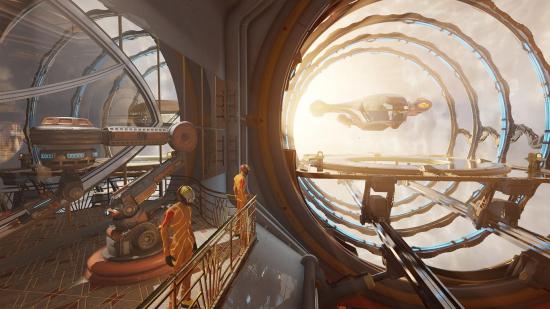3DMark’s ray tracing benchmark, the first of its kind for gaming, is to be shown off publicly for the first time on December 8. While DirectX Raytracing is open for business with Battlefield V, there’s no quantitative measure of a capable graphics card’s innate ability to blast millions of rays around in-game. But that’s where 3DMark’s Port Royal benchmark comes in.
UL, the maker of the 3DMark Fire Strike and Time Spy benchmarks, has another benchmark run up its sleeve, this time utilising ray tracing for reflections, shadows, and “other effects” deemed too unwieldy or costly for traditional rendering. The Port Royal benchmark is built to “test and compare the real-time ray tracing performance of any graphics card that supports Microsoft DirectX Raytracing.”
The unapologetically sci-fi benchmark is making its first appearance at the GALAX GOC Grand Final, an overclocking contest held in Ho Chi Minh City, Vietnam. During which, the world’s top overclockers will try to best each other in the ray tracing benchmark, thus setting the bar dauntingly high for when the run releases to the public sometime in January 2019.
The 3DMark run is supposed to run at “reasonable” frame rates at 1440p, although that’s really all down to the graphics silicon in the test rig. Nvidia is so far the only GPU manufacturer to implement ray tracing specific silicon within its graphics cards, currently only supported in Battlefield V, but more games are coming.
The current RTX 20-series all feature RT Cores capable of driving the ray tracing experience, with the RTX 2080 Ti currently the most suitable card on the market for the job. But there are more coming…
“Port Royal will run on any graphics card with drivers that support DirectX Raytracing,” says the UL release. “As with any new technology, there are limited options for early adopters, but more cards are expected to get DirectX Raytracing support in 2019.”
That’s potentially suggesting lower-end 20-series Nvidia GPUs might get ray tracing support. Yet the benchmark was also made in conjunction with AMD and Intel, too. Despite neither gaming graphics cards capable of the ray tracing compute required… yet. But somewhere down the line it could be on the cards for one or both companies.
On the professional side of things AMD already offers Radeon Rays, its own open-source ray tracing implementation, but is yet to publicly launch anything designed to support DXR.
UL also worked closely with Microsoft on its implementation of the DXR API for the best operation – a benchmark is nothing if not consistent.
The exact release date and pricing will be announced at the GALAX GOC Grand Final event on December 8.

